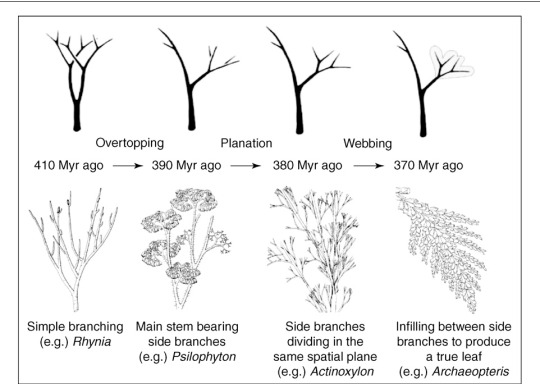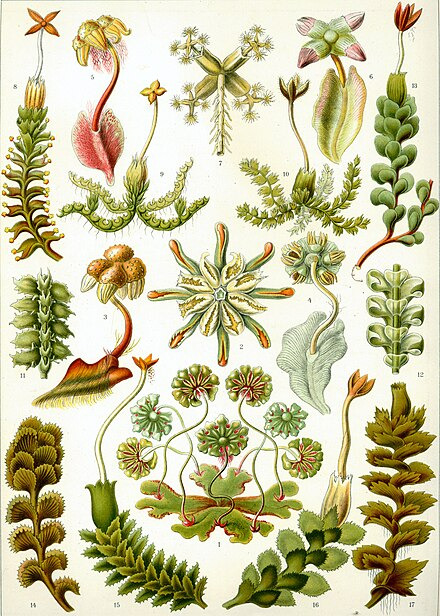Don't wanna be here? Send us removal request.
Text
Happy new year: More on Leaf Evolution from The Emerald Planet.
There's a note on how this blog may continue in the future at the bottom.
Answering the question from the last post:
So, why did it take so long for plants to develop leaves?

Image source: Beerling, D.J., & Fleming, A.J. (2007). Zimmermann's telome theory of megaphyll leaf evolution: a molecular and cellular critique. Current opinion in plant biology, 10 1, 4-12 .
Short answer:
It was due to a complex interplay of phenomena where plants themselves, undergoing a Paleozoic "big bang", caused CO2 to drop by proliferating, growing, and evolving complex body plans, and also weathering continental silicate rocks alongside fungi, which removed more CO2 from the atmosphere, disrupting the previous stasis of the long term carbon cycle (of tectonics, volcanoes, rocks, weathering). Low CO2 then allowed plants to develop more stomata, a precursor to the ability to grow larger leaves. This in turn was a precursor to the growth of taller trees, and further abundant plant diversification.
Long answer:
The first knee high trees and shrubs on the landscape were forking twigs, with no leaves, for 30 million years. 360 million years ago, by the start of the carboniferous, leafy plants were firmly established and widespread among flora. It took about 40-50 million years from the first forking twigs for leaves to be widespread, whereas by comparison, for example, humans evolved from primates in 1/10 of the time. Leaves originated independently in three other plant groups- Sphenopsids, Pteridosperms (ferns) and seed plants.
But, before this marine algae fossils were found in Canadian dolomite with fronds that predated widespread leaved-plants (dated 390 million years ago) with tiny 1-2 mm diameter leaves. Though a full and proper understanding of the genetic mechanisms underlying leaf evolution are still some way off, for now it seems that a genetic "toolkit" for assembly of leaves has been in place long before they proliferated [See Supplemental notes - it's interesting].
400 to 350 million years ago - the same time as the plants' botanical "Cambrian explosion", atmospheric CO2 levels plummeted tenfold, which was unprecedented in the last 500 million years. This led to a major ice age, a weakened greenhouse effect, and the formation of massive glaciers.
How were stomata important in this plant explosion?

Plant leaves have been demonstrated to develop more stomata when there is less atmospheric CO2 - shown by Ian Woodward (1987) from herbaria records, and observations of fewer stomata in trees during the Industrial Revolution with higher CO2 - to conserve water loss. (Interestingly, this happens by mature leaves communicating with newly developing leaves about the optimum number of stomata to produce for the environmental conditions they will soon encounter.)
The number of stomata hold significance for plant's ability to keep cool. More pores confer an increased capacity to keep cool (more transpiration possible), but this is made more difficult with larger leaves, because as air flows over the leaf surface to remove heat, they are slowed by friction of air molecules against the leaf surface, and larger leaves have more surface area, so there is more friction, making their heat loss less efficient than with smaller leaves.
It is thought that a large drop in atmospheric CO2, permitted plants to produce more stomata, which allowed bigger leaves to stay cool and proliferate.
It would be hard to know for certain that it happened exactly like this but also, there are fossils of different plants showing leaf size growth in different types of plants growing in response to CO2 concentrations falling - Archaeopteris, pteridosperms, and a conifer precursor group. This confirms a central prediction of the CO2 hypothesis of later leaf development.
With low CO2 and stomata regulation changing in response to the economics of heat loss in plants, plants also evolved sophisticated root/shoot water transport systems, which increased the capacity to cool down these larger, high-stomata, high transpiration leaves.
A marine animal analogue: Interestingly, a similar barrier / spark has been proposed to have caused the explosion of marine invertebrate animals during the Cambria: Low atmospheric Oxygen was raised, which led to the evolution of complex multi-cellular animals (there is some merit to this because physically larger organisms need more oxygen to sustain their metabolism). Here, as larger, more diverse, marine animals evolved with structures like joints, shells, and complex eyes, they in turn drove the evolution of more complex animals to evade, defend, and protect against predation.
In both cases, ecology itself played a role in transforming the ecosystems as CO2 levels fell. In the botanical case, larger leaves led to the development of taller plants to avoid large leaves.
Plants themselves probably led to the initial CO2 level decline, by disrupting the abiotic processes for exchange of CO2 between rocks, oceans, and the atmosphere. This is referring to the long-term carbon cycle: The earth's cycle wherein volcanic eruptions due to tectonics, cause Co2 release, causing a warmer climate and precipitation, leading to rock weathering, which consumes CO2, weakening the greenhouse effect (a negative/stabilizing feedback loop - think of it as a thermostat that keeps control of global climate over 100s of thousands to millions of years). Plants disrupted this by taking in so much CO2 in their proliferation and evolving appendages/size, and also by developing growing roots that weather rocks, and the weathered rocks then store more CO2.
Even though plants caused the CO2 decline that stressed them and caused them to develop more stomata, their proliferation and diversification shows this kingdom benefitting in the end. And many others living beings were supported by the new abundance of plants.
Source:
Beerling, D. (2017). The emerald planet: how plants changed Earth's history. Oxford University Press.
Notes:
Proper fossil leaf specimens show extinct genus of early trees Archaeopteris, showing plants starting to exploit photosynthetic proficiency of a flat solar panel (i.e. more surface area, flat) for capturing sunlight and powering photosynthesis.
2. Genetics :
KNOX or knotted homeobox genes organize growth and development by ensuring that cells take on the right form and function depending on where they are on the plant. This was critical for leaf formation. This gene can be transferred into different plants and still take on this function, which is to be expected with evolutionary old genes.
KNOX off is a state that causes leaf growth: sideways outgrowth protrude from the shoot which then develop into leaves. And this is the same approach to making leaves developed by many independent plant groups.
Leaf development also requires that genes "know" how to assemble the upper (sunlight intercepting and processing) and lower (CO2 absorbing) parts of their leaves. These genes are also old - about 400 million years old.
Plant adaptation to CO2 concentrations may very well be part of their basic evolutionary existence.
3. People:
Julie Grey discovered the gene that regulates stomata formation, and it is theorized to reduce stomata by depositing specific fatty acids into specialized cells of the pores, and inhibiting neighbor cells from developing more stomata.
Some of the scientists credited with charting the evolutionary trajectory of leaves and making discoveries/insights that led to more discoveries are: Walter Zimmerman (died 1980) and poet/philosopher Johann Wolfgang Goethe - the adventurous ideas of Goethe on plant metamorphosis were accepted by scientists such as Darwin.
Zimmerman's "telome" theory of leaves arising in 4 main steps (3D branching, side branching, further dividing side branches, webbing) explained the how but not why for paleobotanists of leaf development over evolutionary time.
Blog Notes:
Last week I continued to learn geology with some emphasis on causes and consequences of mass extinctions, the evolution of life and paleobiology, marine biology, marine science, wildlife ecology, climate science, astronomy, and physics. I have decided to continue in marine science, and this blog's changing focus should reflect that, as well as further developments. I plan on finishing The Emerald Planet and documenting it here, as there are important foundations on geology, plants, oceans, and their relationships (and, it's a very interesting book).
Main learning sources this week: The Emerald Planet (book, described in this post); Life on Our Planet, Our Planet, Our Planet II (docu-series), Mission Blue (documentary), sporadic scientific articles; astronomy/astrophysics - Our Universe show, various astronomy and telescope research; physics - a brilliant Coursera course, associated readings, Easy Physics podcast).
2 notes
·
View notes
Text
Today, I set a goal. I created this blog to document my learning along the way - at least every Monday could be reasonable.
Welcome to the first post.
Today, this is what I learned.
465 million years ago, photosynthetic creatures began to colonize the land from the ocean. This is mostly the story of green algae, although there were bryophytes like modern liverworts (which can reproduce asexually) hornworts (which like liverworts and mosses have a gametophyte-dominant life cycle), and mosses.
Liverwort photo from Wikipedia ""Hepaticae" from Ernst Haeckel's Kunstformen der Natur, 1904"

425 million years ago - though there is some debate about specifics- a species now known as Cooksonia lived (named by William Lang after colleague last name Cook, 1937) - it had branches, a simple body type, and no leaves. It was important/central to the assembly of terrestrial life.
Later proof of plants with vascular status came by way of fossil evidence of water-conducting tissues as well.
Between 425 to 360 million years ago, plant life began to flourish. It was the plant equivalent of the Cambrian explosion (when marine invertebrate animals went from being single-celled to multi-cellular and complex in a "geological instant" 540 million years ago). In the plant version, land plants transformed, establishing a "blueprint" for the modern plant world, where leaves became widespread seemingly at the last minute of the timeline.
Why did the development of leaves take so long?
More on that, and what makes leaves so important, in the next post.
Source: Beerling, D. (2017). The emerald planet: how plants changed Earth's history. Oxford University Press.
Liverwort Photo and Hornwort parenthetical information: Wikipedia.
4 notes
·
View notes